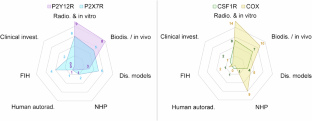PET imaging of neuroinflammation: any credible alternatives to TSPO yet?
IF 9.6
1区 医学
Q1 BIOCHEMISTRY & MOLECULAR BIOLOGY
引用次数: 0
Abstract
Over the last decades, the role of neuroinflammation in neuropsychiatric conditions has attracted an exponentially growing interest. A key driver for this trend was the ability to image brain inflammation in vivo using PET radioligands targeting the Translocator Protein 18 kDa (TSPO), which is known to be expressed in activated microglia and astrocytes upon inflammatory events as well as constitutively in endothelial cells. TSPO is a mitochondrial protein that is expressed mostly by microglial cells upon activation but is also expressed by astrocytes in some conditions and constitutively by endothelial cells. Therefore, our current understanding of neuroinflammation dynamics is hampered by the lack of alternative targets available for PET imaging. We performed a systematic search and review on radiotracers developed for neuroinflammation PET imaging apart from TSPO. The following targets of interest were identified through literature screening (including previous narrative reviews): P2Y12R, P2X7R, CSF1R, COX (microglial targets), MAO-B, I2BS (astrocytic targets), CB2R & S1PRs (not specific of a single cell type). We determined the level of development and provided a scoping review for each target. Strikingly, astrocytic biomarker MAO-B has progressed in clinical investigations the furthest, while few radiotracers (notably targeting S1P1Rs, CSF1R) are being implemented in clinical investigations. Other targets such as CB2R and P2X7R have proven disappointing in clinical studies (e.g. poor signal, lack of changes in disease conditions, etc.). While astrocytic targets are promising, development of new biomarkers and tracers specific for microglial activation has proven challenging.


神经炎症的 PET 成像:TSPO 是否有可靠的替代品?
过去几十年来,神经炎症在神经精神疾病中的作用引起了越来越多的关注。这一趋势的主要驱动力是利用 PET 放射配体靶向 18 kDa 转运蛋白(TSPO)对体内脑部炎症进行成像的能力,众所周知,在炎症事件发生时,活化的小胶质细胞和星形胶质细胞以及内皮细胞都会表达 TSPO。TSPO 是一种线粒体蛋白,主要在小胶质细胞活化时表达,但在某些情况下星形胶质细胞也会表达,内皮细胞也会组成性表达。因此,由于缺乏可用于 PET 成像的替代靶点,我们目前对神经炎症动态的了解受到了阻碍。我们对 TSPO 以外用于神经炎症 PET 成像的放射性同位素进行了系统搜索和回顾。通过文献筛选(包括之前的叙述性综述),我们确定了以下感兴趣的靶点:P2Y12R、P2X7R、CSF1R、COX(小胶质细胞靶点)、MAO-B、I2BS(星形胶质细胞靶点)、CB2R 和 S1PRs(非单细胞类型特异性)。我们确定了每个靶点的发展水平,并对其进行了范围审查。令人吃惊的是,星形胶质细胞生物标记物 MAO-B 在临床研究中的进展最快,而正在进行临床研究的放射性标记物(特别是针对 S1P1Rs 和 CSF1R)却很少。其他靶点,如 CB2R 和 P2X7R,在临床研究中的表现令人失望(如信号差、疾病状况缺乏变化等)。虽然星形胶质细胞靶点很有希望,但开发专门用于小胶质细胞激活的新生物标记物和示踪剂已被证明具有挑战性。
本文章由计算机程序翻译,如有差异,请以英文原文为准。
求助全文
约1分钟内获得全文
求助全文
来源期刊

Molecular Psychiatry
医学-精神病学
CiteScore
20.50
自引率
4.50%
发文量
459
审稿时长
4-8 weeks
期刊介绍:
Molecular Psychiatry focuses on publishing research that aims to uncover the biological mechanisms behind psychiatric disorders and their treatment. The journal emphasizes studies that bridge pre-clinical and clinical research, covering cellular, molecular, integrative, clinical, imaging, and psychopharmacology levels.
 求助内容:
求助内容: 应助结果提醒方式:
应助结果提醒方式:


